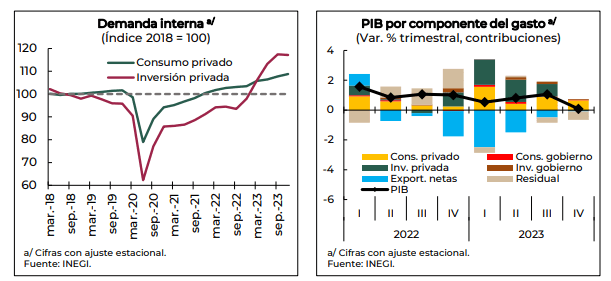Aggregate demand in Mexico grew in 2023 for three consecutive years and above its historical average, mainly due to positive labor market conditions and business confidence to invest in the country, according to the Ministry of Finance (SHCP).
Thus, in 2023 it increased by 4.0% annually, with positive contributions of 2.1 and 2.9 percentage points (pp) from private consumption and investment, respectively.

What is aggregate demand? It is an indicator that reflects the total amount of goods and services demanded within the country in a specific period of time.
This indicator is made up of consumption, gross fixed capital formation and exports.
Meanwhile, exports of goods and services contracted 6.9% in Mexico, which subtracted 2.0 pp from the total, showing a less dynamic performance of the external sector.
The 4.0% increase in consumption in 2023 was driven by the private consumption component, which outperformed its historical performance by increasing 4.3% annually, while the public component registered the largest increase in the last five years, with an annual rise of 2.1 percent.
Aggregate demand
Within private consumption, the greatest dynamism came from the imported component, which contributed 2.3 pp, mainly due to the purchase of non-durable goods.
In turn, domestic consumption increased by 1.7% due to the effect of services and durable goods.
Total investment recorded the highest contribution to aggregate demand growth since records began in 1993, growing 19.5% annually in 2023.
Within it, the construction component stood out with an annual increase of 20.8% due to civil engineering works and non-residential construction.
External sales
Additionally, the machinery and equipment component also grew by 18.1% annually, mainly due to domestic transportation equipment, after several years of shortage of components for vehicle production and high demand within the country.
With respect to exports, their 6.9% annual decline detracted from the pace of aggregate demand. This was mainly due to the bottlenecks registered in the last quarter of 2023 at the border with the United States, with effects on the domestic production and supply chain.

